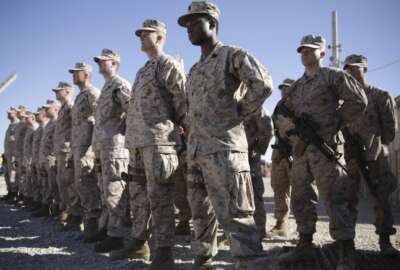Best listening experience is on Chrome, Firefox or Safari. Subscribe to Federal Drive’s daily audio interviews on Apple Podcasts or PodcastOne.
The Defense Department officially started its crackdown on nondeployable troops Monday.
The policy, which the Pentagon released in July, states if a service member is unable to be deployed for 12 months or more then he or she may be separated from the military.
The Pentagon estimated there are about 126,000 nondeployable troops as of Aug. 31, but that doesn’t mean all of them will be losing their jobs.
“This is always rolling. People always become injured or nondeployable for an administrative or legal reason and then they become deployable again,” said Patricia Mulcahy, DoD director of Officer and Enlisted Personnel Management in a call with reporters Tuesday.
It is only the troops on that list who continue to be nondeployable for a year or more that are in danger of losing their jobs. Some troops go on to the nondeployable list for just a month for something like a sprained ankle.
Separation decisions are made at the service level. DoD is mostly asking for more reporting on the nondeployable troop numbers.
This policy “shined a bright light on the defense secretary’s interest for the services on this issue,” said Mike Melilo, DoD deputy director of force management. “As soon as the secretary asked this question and he now requires reporting across the total force, it’s a natural thing for someone when they have to report numbers to now look at their numbers and not take them for granted.”
The policy exempts pregnant and postpartum service members, but they are the only group getting a pass in the policy.
Troops who have been non-deployable for more than a year may obtain a waiver from the secretary of their military department to stay in the service. The secretary will grant waivers to troops who have specialties or who may have an injury that can heal in 14 months instead of 12, Mulcahy said.
DoD’s umbrella policy asks each service to handle the nondeployabilty issue and release their own rules. The Navy already released its guidance for the policy.
“It is the personal responsibility of every sailor to maintain individual readiness, including medical, dental, physical and administrative (e.g., maintaining a family care plan) readiness. Medical deployability will be considered during each healthcare encounter,” the policy states.
The policy states starting Oct. 1, sailors who have been nondeployable for 12 consecutive months will be notified for mandatory processing for separation or referred to the military evaluation system.
In February when DoD first floated the idea of the policy, it reported about 14 percent or 280,000 of its troops were nondeployable. That number dropped by almost half to about 6 percent of the total force by the end of August. Defense Secretary James Mattis said he would like to keep the number below 5 percent.
“What we’ve seen in the lead up to the formal reporting of this is that with the greater emphasis at all levels of command we’ve seen some of those nondeployable numbers come down,” Melilo said.
The purpose of the policy is to increase the lethality of the force, Mulcahy said.
She added that the purpose is not to push people out of the military, but rather to emphasize getting troops to deployable status. That may include moving medical centers closer to bases or focusing more on sports medicine.
“The situation we face today is really unlike anything we have faced, certainly in the post-World War II era,” then-Undersecretary of Defense for Personnel and Readiness Robert Wilkie said during a Feb. 14 Senate Armed Services Personnel Subcommittee hearing. “If Mr. [Jeff] Bezos at Amazon walked into Christmas week and 14 percent of his workforce could not perform their duties then [it] would no longer be the largest company in the world.”
Mulcahy said DoD did not have an idea as to how many people would initially be cut from the ranks due to the policy.
Some of the services have provided some ideas though.
Gen. Glenn Walters, the Marine Corps assistant commandant, said in March less than 0.5 percent of the Marine total force is “truly nondeployable.”
“About 1,000 [nondeployable Marines], that’s about what we’ve been seeing for a long time. When do I get worried about it? As soon as non-deployable status in the Marine Corps affects our ability to meet our staffing goals both on the supporting establishment side and the operational side,” Walters said.
Copyright
© 2024 Federal News Network. All rights reserved. This website is not intended for users located within the European Economic Area.
